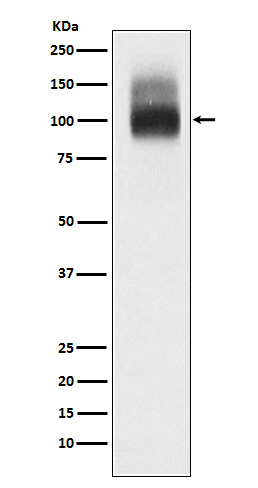
| WB | 咨询技术 | Human,Mouse,Rat |
| IF | 咨询技术 | Human,Mouse,Rat |
| IHC | IHC:1/100-1/200;IHF:1/50-1/200 | Human,Mouse,Rat |
| ICC | 1/50-1/200 | Human,Mouse,Rat |
| FCM | 咨询技术 | Human,Mouse,Rat |
| Elisa | 咨询技术 | Human,Mouse,Rat |
| Aliases | AE1; BND3; CD233; DI; EMPB3; EPB3; FR; RTA1A; SLC4A1; SW; WD; WD1; WR;;SLC4A1 |
| WB Predicted band size | 102 kDa |
| Host/Isotype | Rabbit IgG |
| Antibody Type | Primary antibody |
| Storage | Store at 4°C short term. Aliquot and store at -20°C long term. Avoid freeze/thaw cycles. |
| Species Reactivity | Human |
| Immunogen | A synthesized peptide derived from human SLC4A1 |
| Formulation | Purified antibody in PBS with 0.05% sodium azide,0.05% BSA and 50% glycerol. |
+ +
以下是关于Band3/CD233抗体的3篇参考文献,涵盖结构、疾病应用及病原体相互作用的研究方向:
---
1. **文献名称**:*"Structural characterization of the human erythrocyte anion exchanger (Band 3) in complex with a monoclonal antibody"*
**作者**:Bruce, L.J., et al.
**摘要**:该研究通过冷冻电镜技术解析了人红细胞Band3蛋白与特异性单克隆抗体结合的复合体结构,揭示了抗体识别Band3胞外域的抗原表位,为理解抗体介导的Band3功能抑制提供了结构基础。
---
2. **文献名称**:*"CD233 (Band 3) autoantibodies in hereditary spherocytosis: Diagnostic utility and pathogenic implications"*
**作者**:Ribeiro, M.L., et al.
**摘要**:文章评估了抗Band3抗体在遗传性球形红细胞增多症(HS)中的诊断价值,发现通过流式细胞术检测红细胞表面Band3的表达水平可作为HS的辅助诊断指标,并探讨了抗体异常识别导致红细胞破坏的机制。
---
3. **文献名称**:*"Antibody targeting of Band 3 enhances Plasmodium falciparum clearance in a murine model"*
**作者**:Okoye, V.N., et al.
**摘要**:研究利用抗Band3单克隆抗体阻断疟原虫(Plasmodium)入侵红细胞的机制,在小鼠模型中证实抗体通过竞争性结合Band3胞外域抑制寄生虫粘附,为抗疟药物开发提供了新思路。
---
4. **文献名称**:*"Anti-Band 3 antibodies in autoimmune hemolytic anemia: Epitope mapping and functional effects"*
**作者**:Hsu, Y.R., et al.
**摘要**:该文献分析了自身免疫性溶血性贫血(AIHA)患者体内的抗Band3抗体,鉴定其结合表位并证明这些抗体通过激活补体途径加速红细胞清除,揭示了AIHA的分子病理机制。
---
这些文献展示了Band3/CD233抗体在基础研究、疾病诊断及治疗中的多样化应用。
Band3. also known as CD233 or anion exchanger 1 (AE1), is a transmembrane glycoprotein encoded by the SLC4A1 gene. It is predominantly expressed on the surface of erythrocytes, where it plays a critical role in gas exchange by facilitating the chloride-bicarbonate exchange, thereby maintaining cellular pH and CO₂ transport. Structurally, Band3 consists of two domains: a N-terminal cytoplasmic domain that anchors the cytoskeleton to the membrane, and a C-terminal membrane-spanning domain responsible for ion transport.
Antibodies targeting Band3/CD233 are widely used in research and diagnostics. In hematology, they help identify erythrocyte membrane abnormalities linked to hereditary disorders like hereditary spherocytosis or Southeast Asian ovalocytosis. Band3 is also implicated in autoimmune hemolytic anemia, where autoantibodies disrupt erythrocyte integrity, leading to premature cell destruction. Additionally, Band3 serves as a receptor for Plasmodium falciparum in malaria pathogenesis, making it a potential therapeutic target.
In cancer research, Band3 expression has been observed in certain solid tumors, though its role remains unclear. Anti-Band3 antibodies are essential tools for studying erythrocyte aging, as clustered Band3 proteins signal for phagocytic removal of senescent red blood cells. These antibodies are typically generated in mice or rabbits and validated via flow cytometry, Western blot, or immunofluorescence. Their versatility underscores Band3’s physiological importance and relevance in disease mechanisms.
×